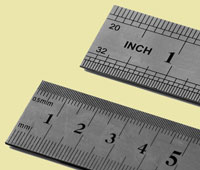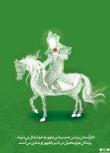
بابلیان،مصریان، یونانیان و چینی ها هر کدام واحدها و اجزاء اندازه گیری طول و دیگر کمیّات فیزیکی، نظیر مساحت، وزن و حجم مایعات،خاصِ خود داشتند.

در قرن سیزدهم میلادی انگلیسی ها ، معیار یارد را ابداع نمودند و آنرا به3فوت(پا) و هر فوت را به 12 اینچ تقسیم نمودند.علاوه بر این میله ای را که اندازه اش برابر 5/5 یارد بود و نیز واحد طولی را که یک هشتم میل درازا داشت ارائه دادند.در سال 1878 برای یارد تعریف جدیدی عنوان شد که عبارت بود از "خط مستقیم یا فاصله بین مرکز دو میله یا سوزن طلائی یا برنزی ...در شرایطی که درجه حرارت محیط 62درجه فارنهایت بوده و غلطکهای برنزی به عنوان تکیه گاه در زیر آن قرار گیرد تا از خم شدن میله جلوگیری شود"
انقلاب فرانسه سیستم متریک را به ارمغان آورد.
در سال 1792لویی شانزدهم فرمانی صادر کرد که به موجب آن دو مهندس مأمور شدند با مقیاس متریک به اندازه گیری نصف النهاری که از بارسلون اسپانیا تا دانکرک فرانسه امتداد داشت ، مبادرت نمایند.لاکن بدلیل وقوع جنگ داخلی انجام این امر سالها به درازا کشید.
چهار سال پس از آن یعنی در سال 1795مقیاس متر موقتی توسط مجمع فرانسوی تعیین گردید؛ این معیار متر عبارت بود از:
"یک ده میلیونیم از ربع نصف النهاری از کره زمین".
مجددا در ماه اکتبر سال 1960 تعریف جدیدی از متر عنوان شد که عبارت بود از طول موج1650753/73 در خلاء و در طیف نارنجی-قرمز کریپتون86.
Yard and inch

In a law of 1439 (18 Henry VI. Cap. 16.) the sale of cloth by the "yard and handful" was abolished, and the "yard and inch" instituted.[1]
There shall be but one Measure of Cloth through the Realm by the Yard and the Inch, and not by the Yard and Handful, according to the London Measure.
According to Connor, cloth merchants had previously sold cloth by the yard and handful to evade high taxes on cloth (the extra handful being essentially a black-market transaction). Enforcement efforts resulted in cloth merchants switching over to the yard and inch, at which point the government gave up and made the yard and inch official. In 1552, the yard and inch for cloth measurement was again sanctioned in law (5 & 6 Edward VI Cap. 6. An Act for the true making of Woolen Cloth.)[2]
"XIV. And that all and every Broad Cloth and Clothes called Taunton Clothes, Bridgwaters, and other Clothes which shall be made after the said Feast in Taunton, Bridgwater or in other Places of like Sort, shall contain at the Water in Length betwixt twelve and thirteen Yards, Yard and Inch of the Rule, and in Breadth seven Quarters of a Yard: (2) And every narrow Cloth made after the said Feast in the said Towns or elsewhere of like Sorts, shall contain in the Water in Length betwixt three and twenty and five and twenty Yards, Yard and Inch as is aforesaid, and in Breadth one Yard of like Measure; (3) and every such Cloth, both Broad and Narrow being well scowred, thicked, milled and fully dried, shall weigh xxxiv. li. the Piece at the least."
"XV. And that all Clothes named Check-Kersie and Straits, which shall be made after the said Feast shall contain being wet between seventeen and eighteen Yards, with the Inches as is aforesaid, and in Breadth one Yard at the least at the Water; and being well scowred, thicked, milled and fully dried, shall weigh xxiv. li. the Piece at the least."
And once in legislation of 1557-8 (4 & 5 Philip and Mary Cap. 5. An act touching the making of woolen clothes. par. IX.)[3]
"IX. Item, That every ordinary kersie mentioned in the said act shall contain in length in the water betwixt xvi. and xvii. yards, yard and inch; and being well scoured thicked, milled, dressed and fully dried, shall weigh nineteen pounds the piece at the least:..."
As recently as 1593 we find the same principle mentioned once again (35 Elizabeth. Cap. 10. An act for the reformation of sundry abuses in clothes, called Devonshire kerjies or dozens, according to a proclamation of the thirty-fourth year of the reign of our sovereign lady the Queen that now is. par. III.)[4]
"(2) and each and every of the same Devonshire kersies or dozens, so being raw, and as it cometh forth off the weaver"s loom (without racking, stretching, straining or other device to encrease the length thereof) shall contain in length between fifteen and sixteen yards by the measure of yard and inch by the rule,..."
Conversions
- international yard (defined 1959):
1 yard = 0.9144 metre.
- pre-1959 US yard - defined 1869, implemented 1893
For survey purposes, certain pre-1959 units were retained, usually prefaced by the word "survey," among them the survey inch, survey foot, and survey mile, also known as the statute mile. The rod and furlong exist only in their pre-1959 form and are thus not prefaced by the word "survey." However, it is not clear if a "survey yard" actually exists. If it did, its hypothetical values would be as follows:
3937 survey yard = 3600 metre
1 survey yard ≈ 0.91440183 metre
0.999998 survey yard = 1 yard (exact)
1 statute mile = 8 furlongs = 80 chains = 1760 yards
History of the metric system and its adoption in the USA .[6]
The metric system is a system of measurement which was developed over many years, and traces its origin to a 1585 book entitled "The Tenth," by Simon Stevin, who suggested that a decimal system be used for weights and measures. Around 1670, Gabriel Mouton, a French vicar who studied mathematics and astronomy, proposed a decimal system of measurement based on the size of the earth. In 1790, Thomas Jefferson proposed a decimal-based system of measurement for the United States and France"s King Louis XVI authorized scientific investigations aimed at reforming French weights and measures. The development of the first "metric system" arose out of these investigations.
In 1795, France officially adopted the metric system. Many years later, the use of the metric system was made legal (but not mandatory) in the United States by the Metric Act of 1866.

During the early 1870s, a series of meetings was held to reformulate the metric system and refine the accuracy of its standards. In 1875, at The Convention of the Metre in Paris, the United States committed to the development of an internationally recognized metric system by signing the "Treaty of the Meter," along with 16 other nations. This treaty established the International Bureau of Weights and Measures (BIPM) in Sevres, France, to provide standards of measurement for use worldwide.
In 1893, metric standards developed under the auspices of the BIPM were adopted as the fundamental standards for length and mass in the USA. The conversion ratios between our customary measures — the foot, mile, acre, gallon, etc. — and metric system units were defined at that time.
In 1960, the General Conference of Weights and Measures, the metric system"s governing body which is comprised of Treaty of the Meter signatory nations, approved an updated version of the metric system, known as the International System of Units, abbreviated SI.
In 1968, the United States Congress authorized a three-year study of measurement systems in the USA, and in 1975, Congress passed the Metric Conversion Act of 1975 "to coordinate and plan the increasing use of the metric system in the United States." The U.S. Metric Board was established and a process of voluntary conversion was begun. However, the efforts of the Metric Board were largely ignored by the American public, and the Metric Board was dis-established in 1982. More recently, in the Omnibus Trade and Competitiveness Act of 1988, Congress amended the Metric Conversion Act of 1975 and designated the metric system as the preferred system of weights and measures for United States trade and commerce.
Today, some business and technology companies in the USA use the metric system, and many products specify both English and metric units. But the American public has decided, collectively, that the short term costs and disruptions of converting to the metric system would outweigh the potential long term benefits.
Source:
-
1-· ^ Statutes at Large. 1763. p. 594. Retrieved 8 January 2012.
2-· ^ Owen Ruffhead, ed. (1763). The statutes at large. 2. p. 442. Retrieved 29 February 2012.
3-· ^ Great Britain; Pickering, Danby (1763). Danby Pickering. ed. The statutes at large. 6. Printed by J. Bentham. p. 96. Retrieved 29 February 2012.
4-· ^ Great Britain; Pickering, Danby (1763). The statutes at large]. 6. Printed by J. Bentham. p. 444. http://books.google.com/books?id=dvouAAAAIAAJ&pg=PA444. Retrieved 29 February 2012.
5.http://www.fttoolkit.co.uk/2011mediakit/history_video.html
6.http://www.metricconversion.us/system.htm
لطفا در صورت کپی برداری منبع ذکر گردد.شایگان.
